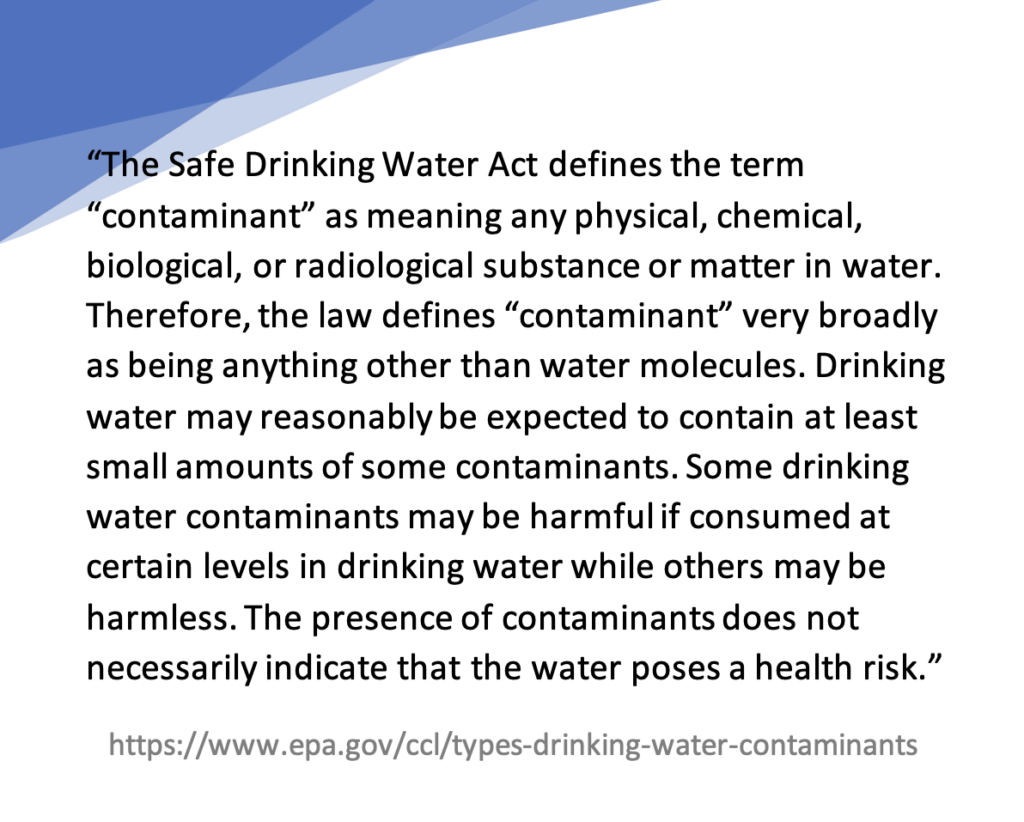Drinking water is a primary exposure pathway for PFAS contamination everywhere. This stark reality enforces the certainty that the dynamic, growing problem of PFAS touches not only our clients who we support to address complex remediation projects around the country, but also, you and me. PFAS, a man-made class of chemicals, are a serious threat, with some known to cause adverse health effects including cancers, and most of the human population has frequent exposures whether we know it or not.
This Water Quality Month, our practitioner Lisa Kammer, PG shares background and original insights you need to know about the current regulatory landscape for drinking water and PFAS as a key contaminant, as well as hope for the future and practical tips to practice sound water quality safety and advocacy.
PFAS In Our Drinking Water and How It’s Regulated
As environmental professionals, we are always studying and applying regulations instituted at the state and federal levels to help our clients achieve and maintain compliance with approved guidance or promulgated values. Currently, regulatory controls are catching up to public concern and awareness of PFAS, and all are championing sound, science- and data-based decisions. Many states have regulated, or are in the process of regulating, PFAS in drinking water, and those that did so early have moved forward with regulating other environmental media and instituting various types of consumer protection laws [1].
It’s important to understand how our drinking water is regulated. Congress passed the Safe Drinking Water Act (Act) in 1976 and it has been amended twice: in 1986 and again in 1996. Through the Act, “only a small number of the universe of contaminants… are listed on the Contaminant Candidate List” [2], which is the first step to regulating any contaminant in our drinking water. The Act specifies the process that the U.S. Environmental Protection Agency (EPA) must follow to evaluate and eventually regulate contaminants. After a contaminant is identified as a potential issue, it is then evaluated for regulation. Obviously, other regulations are intended to prevent the accidental, intentional, or otherwise release of chemicals to the environment, but to be effective, those rules must be understood and followed with sometimes minimal oversight. Regarding PFAS and the multitude of ways we are exposed, and that they have been so easily transported to the farthest reaches of the planet, our regulations appear ineffective. PFAS studies have generally caused us to consider what else is in our water that we aren’t even looking for yet. What is tomorrow’s PFAS going to be?

The EPA’s proposed final rule for PFAS will dictate maximum contaminant levels (MCLs). Under the Act, EPA is authorized to establish enforceable National Primary Drinking Water Regulations, which are legally enforceable MCLs. By law, proposed drinking water standards must also consider the financial implications of those regulations [3]. As an example, as recently as August 2022, the Office of Management and Budget completed its review of EPA’s proposed rule to designate PFOA and PFOS (members of the chemical group PFAS) as hazardous substances under CERCLA. This designation will have significant financial impacts to those companies and previously closed or delisted hazardous waste sites with legacy PFOA/PFOS issues as well as those with adjacency like insurers, investors, local governments, etc.
Therefore, we must also consider the cost to identify and to fix the PFAS problem at the low MCLs we expect EPA to propose later in 2022. By winter 2022, the EPA plans to leverage federally issued water permits under the National Pollution Discharge Elimination System (NPDES) program to reduce PFAS discharge and will propose monitoring requirements at facilities where PFAS are expected or suspected to be present in wastewater and stormwater discharges, using its recently published draft analytical method 1633, which covers 40 unique PFAS [4].
So far, the high cost to remediate PFAS is met with limited assurances that the problem is truly resolved as we await those promulgated criteria. At the risk of oversimplifying the issue, the cost to remediate PFAS is generally driven upward by limited viable destruction technologies, handling the labile spent adsorbing material such as activated carbon media, the nature of PFAS chemistry, and the low target remedial criteria. This cost will only increase once two of the most common PFAS are designated hazardous wastes.
Lisa Says We’re in This Together
The stakes surrounding these issues and this work are high: human health, our precious water resource, and the convergence of public and policy awareness and action facing various unknowns. However, it’s also a tremendous time of growth and collaboration in the industry. There’s a lot of power in the knowledge that practitioners and society at large are gaining. We continue to see great opportunities to build diverse teams to address some of the most significant and challenging PFAS problems faced by our clients. PFAS have given us the opportunity to band together to address a problem that we humans created, and the progress and intelligent dialogue gives me a lot of hope.
Working with Weston on This Issue
Weston experts have always been leaders in professional organizations like: the Interstate Technology and Regulatory Council PFAS Team; the National Groundwater Association; and the Society of American Military Engineers, Environmental Community of InterestPFAS Industry-Government Engagement Project. All these organizations serve to educate people, track and, in some cases, develop guidance documents including tracking regulations that are proposed through legislative processes. Our technical staff work directly with multiple different technology developers, universities, and research organizations to help demonstrate the viability of remedial technologies. From the strength of our innovative, tightly integrated technical Communities of Practice, it’s our job and our proud purpose to know what’s ahead on the regulatory landscape and help clients prepare for how these changes will affect them and their businesses. Having the benefit of foresight into pending regulations and developing technologies, combined with our innovative application of demonstrated technologies, our services are a clear cost benefit for clients in the investigation and remediation phases of work.
Your Drinking Water
Who doesn’t want to know what’s in their water? Clean, safe free water is a basic human right, but you don’t have to be an environmental professional to become informed, ask questions, and take initiative for yourself, your family, and your community. Educate yourself with reliable, scientific information. It is easy to get overwhelmed by information on the internet, so having a tether to reality is important. Municipal water utilities are required to test their water for a variety of contaminants that may include PFAS, and you can get a free copy of their report. Private well owners can have their water tested. If you have PFAS in your water at levels that concern you, there are point of use and point of entry treatment options available. Many state environmental agencies have educational information for such occurrences and some, like the state of New Hampshire, also offer funding for private well owners to sample and treat their water wells.
This Just In
As we were finalizing this article for publication, two significant steps in the process of federal regulations were taken. On August 22, 2022, the EPA’s Scientific Advisory Board (SAB) PFAS Review Panel released the final report titled, “Review of EPA’s Analysis to Support EPA’s National Primary Drinking Water Rulemaking (NPDWR) for PFAS”. Although the SAB had multiple suggestions for areas EPA could improve upon in their final revised documents, they appeared to give the EPA approval to move forward with the NPDWR process for PFAS. With that, expect to see low MCLs for PFOA and PFOS later this year [5]. On August 26, the EPA formally announced their proposal to designate PFOA and PFOS as hazardous substances under CERCLA. EPA expects to publish the Notice of Proposed Rulemaking in the Federal Register within weeks. Following publication is a 60-day comment period. EPA could then issue an Advance Notice of Proposed Rulemaking to solicit further comment on designating other PFAS as CERCLA hazardous substances. This rulemaking sets into motion a series of actions that will impact numerous public and private industries by establishing reporting requirements and an increase in risk related to site cleanup [6].
Learn more about drinking water quality in your state: https://www.cdc.gov/healthywater/drinking/public/water_sources.html
Browse recent Weston water quality projects: Projects – Weston Solutions
Sources:
[1] Per- and Polyfluoroalkyl Substances (PFAS) | State Legislation and Federal Action (ncsl.org) (https://www.ncsl.org/research/environment-and-natural-resources/per-and-polyfluoroalkyl-substances-pfas-state-laws.aspx)
[2] Types of Drinking Water Contaminants | US EPA (https://www.epa.gov/ccl/types-drinking-water-contaminants)
[3] SDWA Economic Analysis | US EPA (https://www.epa.gov/sdwa/sdwa-economic-analysis)
[4] https://www.epa.gov/system/files/documents/2021-10/pfas-roadmap_final-508.pdf
[5] https://sab.epa.gov/ords/sab/f?p=100:18:16490947993:::RP,18:P18_ID:2601

